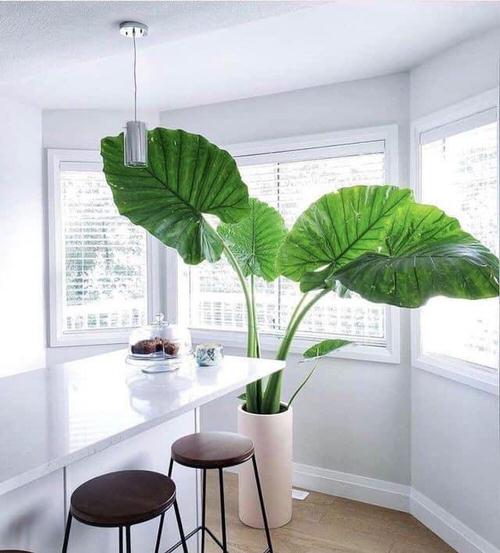If you want a large foliage houseplant that’s easy to grow and maintain, then Growing Elephant Ear Plant Indoors makes perfect sense!

Elephant ear plants have huge leaves and make quite a bold impression. They can be a great focal point with a dramatic appeal for any interior. The color of foliage may differ from variegated green, purplish-black to green-white. Here are all the details on Growing Elephant Ear Plant Indoors!
Other Names: Taro, Cocoyam, Elephant ear, Eddoe, Hembu, Saru and, Dasheen
Check out our article on the best large foliage plants for indoors here
Types of Elephant Ear Plants

There are two most common types of Elephant Ear plants:
- Colocasia, the leaves have their pointed tips downwards and prefer full sun, hence are grown outdoors.
- Alocasia, the leaf points upwards and is a well-known houseplant variety for its ability to thrive in partial shade.
To have a detailed look at types of Elephant Ear plants, click here
Choosing a Container
The size of the container depends on the variety of the plant. For nursery brought plants, go for one or two sizes bigger pot than the rootball. Varieties like Alocasia can do well in small pots while you’ll need a bigger pot for Xanthosoma.
Revamping the Interior Decor with Elephant Ear Plants

- Thanks to its dramatic and large foliage, the plant can be a focal point of your interior decor. Keep it in a large and glossy container for a bold impression.
- To up the style quotient, you can display its huge green leaves with other variegated plants like Philodendron Birkin, Monstera Deliciosa ‘Albovariegata’, and Calathea!
- It would be a great idea to club Elephant Ear Plants, Fiddle Leaf Fig, Cannas, and Bird of Paradise in a large living room together.
Quick Tips to Ensure Your Elephant Ear Plant Stays Happy Indoors
- Ensure to never keep the plant at a dark and shady spot. Being a tropical plant, it loves bright and indirect light.
- Keep it near a window where the plant gets plenty of air circulation.
- The large ear-shaped leaves of the plant make quite a bold impression, right! To make sure they continue to do so, it would be a good idea to wipe them with a damp and soft cotton cloth once in 10-15 days. It will keep them shining like new!
Growing Elephant Ear Plant Indoors

Wear gloves before planting elephant ear plants, as the sap is mildly irritating for the skin.
Location
The Colocasia variety needs a minimum of 4-5 hours of sun to thrive well, while Alocasia can be kept at a place that receives bright indirect sun all day. Make sure to keep the plant away from the scorching summer sun or sudden heat and cold drafts.
Avoid keeping the plant at a dark spot or a shady location as it will stunt its growth.
Watering
The elephant ear plant loves to remain hydrated all the time, but overwatering can be harmful. Since you’re growing them indoors, it’s better to wait and let the soil dry out a bit before watering again.
Temperature
They thrive well in temperature between 15-25 C (60-80 F). The ideal temperature for an elephant ear plant is above 50 F (10 C). Mulch the plant well in winters.
Soil
For growing elephant ear plants indoors, try to imitate wetland by mixing peat and perlite with organic-rich material that holds moisture, but don’t forget that every indoor plant needs well-draining soil.
Elephant Ear Plant Care

Fertilizer
Feed the elephant ear with all-purpose liquid fertilizer, once in 2 months. Avoid fertilization in winters and allow them to relax.
Humidity
Adequate humidity is a must for the elephant ear plant. You can use a humidifier for this purpose. Also, avoid dry air and keep it away from the heater and AC vents. To increase humidity for houseplants check out our detailed article here.
Repotting
When new growth or pups start to emerge, you can transplant elephant ear plants in separate containers. It will help in providing space for existing plants, and new growth will also find their own space to flourish without any hurdles.
TIP: Just remove the newly grown pups and repot them in organic-rich soil in a deep and wide container.
Pests and Diseases
Fungal leaf blight can cause tiny oval lesions on leaves, making them yellow or purple after drying. Phyllosticta might affect the plant too. In an area with too much water and humidity, the plant may get subjected to pythium rot. To prevent, apply a copper fungicide. Keep the leaves dry and water the stem.
Be careful about the pests like spider mites and thrips. They can be taken care of by the use of neem oil and insecticidal soaps.
Toxicity
The stems and leaves are toxic to pets and humans as it holds oxalic acid in the form of sharp crystals. It may cause skin irritation, swelling, and vomiting. Though Colocasia (Taro) is widely consumed in many dishes around the world.
Cooking properly eliminates the crystals completely. If you apply any lotion or oil on your hands before touching them, then it won’t hurt you.


